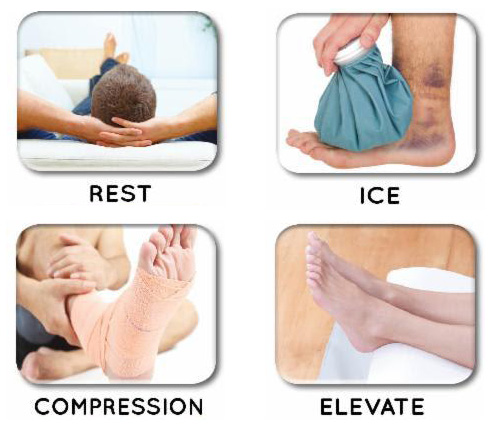The weather is getting nice, which means you will be outside running and jumping and biking on a more consistent basis. No matter how careful you are though, injuries happen. Stepping off the curb wrong, planting your foot at an awkward angle while turning, hiking on an uneven surface… These simple mistakes can lead to a major problem: the dreaded ankle sprain!
The ligaments surrounding the ankle are surprisingly fragile. A seemingly harmless motion has the potential to cause serious damage. Although we cannot prevent the injury, we can limit the damage.
The protocol used in Athletic Training after a sprained ankle is R.I.C.E. (Rest, Ice Compression, Elevation). We use this technique to reduce the amount of inflammation, providing the injury site with an optimal healing environment in the days or weeks to come. Learn how to use each step below.
Rest: Immediately following an ankle sprain, give your limb some rest. Take the remainder of the day off to protect your ankle from further injury. If you need to get around, use crutches if they are available. The more walking around, the more damage you will cause, and the longer your recovery will be.
Ice: Get ice on the ankle as quickly as possible. Ice limits the amount of blood flow to the injured area, which reduces swelling, and also helps reduce the pain, redness and warmth common to ankle sprains. Ice can be applied for 20 minutes at a time, every hour. DO NOT HEAT for the the first 48-72 hours. Heat will cause increased blood flow, resulting in increased swelling. Note: be careful with chemical ice packs. Make sure you have a barrier (paper or dish towel) between the ice pack and your skin.
Compression: Apply an elastic bandage to your ankle between icing sessions and while sleeping. Compression helps to push the swelling away from the site of injury and back into circulation. Wrap the bandage from your toes (tighter) to your calf (looser), but not too tight so that you cause numbness, tingling, or increased pain. Elastic bandages also give the added effects of immobilization and support.
Elevation: As much as possible, lay down with your ankle elevated above your heart. Use gravity to help bring the pooling blood and exudate back up your leg and into proper circulation. For best results, place a large object under the foot of your mattress at night.
Use these simple treatment techniques when dealing with acute ankle injuries. If you believe your injury may be more serious, seek medical advice.

